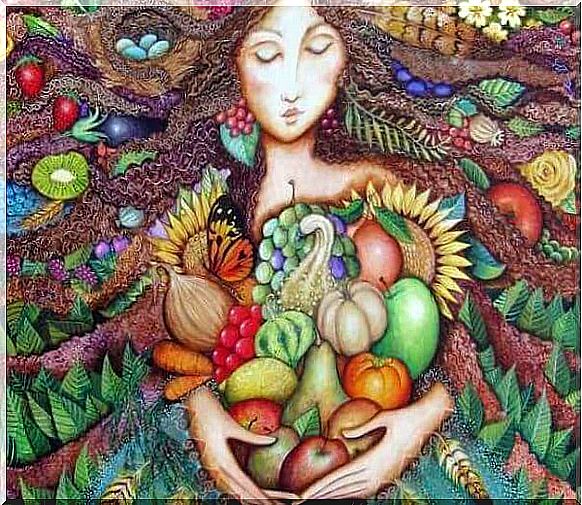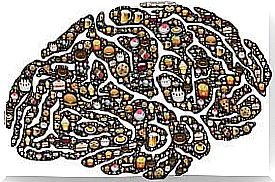What Is The Link Between Emotion And Food?

Our emotions have a powerful effect on our food choices and eating habits. For example, it has been found that the link between emotion and food is stronger in obese people than in non-obese people and in dieters in relation to people who do not diet (Sánchez and Pontes 2012).
It has also been suggested that emotions are not in themselves the cause of overweight, but rather the way to manage these emotions and the coping style are the factors that most influence the appearance of overweight.
What we eat not only affects how we feel, but how we feel also affects the way we eat. In this sense, Cooper et al. (1998) tell us that the difficulty in regulating negative mood states has a very large influence on the appearance and maintenance of eating disorders.
Emotional regulation refers to people’s management of their own emotions, taking into account the circumstances and emotional state of others. Thus, it has been observed that shame and guilt are the emotions that can have a greater negative impact on the diet. As we see the link between emotion and food is more important than we think.

Emotion and food: a necessary tandem for our health
People develop different behaviors in response to their emotions depending on various factors, such as the environment in which they find themselves, their training and their ability to identify and manage their feelings. As a result, they can control their weight better or worse. For example, it has been observed that the more emotional the person is in their intake, the more uncontrolled they have in the number of meals, the elimination of breakfast being constant in their eating routine. As we can see, the link between emotion and food is a fact.
The most influential emotional factor in sedentary people is disinhibition in food and indulging cravings for certain foods such as chocolate and pastry. However, in athletes, guilt emotions, such as fear of the scale and eating sweets, have had more influence than emotions of disinhibition in food.
The emotional factors in sedentary people are more dysfunctional than those of sports people. Excess cravings and lack of control over eating are more related to overeating and eating behavior problems.
There is a specific group of individuals who, due to their eating habits, have been called “repressed” eaters or chronic dieters. These people are characterized by experiencing an exacerbated fear of gaining weight, restricting their diet through diets. Paradoxically, under these restrictive conditions, these individuals increase their intake levels by overeating.
Abusing the pleasurable act of eating can not only make us feel more tired and constantly search for more food, but it can cause serious health problems. The emotion and food tandem has to be based on eating exactly what we need. Our emotion is what has to make us aware of the food we need.
The food ban fixes the obsession with food
The greater the prohibition, the greater the risk of binge eating. The normalization of food has to be an essential objective in the treatment of food decontrol. The purgative behaviors act as reinforcements to the eating behavior and therefore favor the lack of food control in addition to posing important risks to health.
To show that the prohibition of food fixes the obsession with food, I am going to propose a phrase like “I am going to tell you a phrase that you should not remember later”. Example: there is a yellow butterfly in the room. This produces the opposite effect, and when we are told that we cannot remember what we have been told automatically, our brain cannot stop processing that information.
The cause of this happening is rooted in the unconscious. The unconscious is the part that is in charge – in an important part – of directing our body, interpreting and storing the information received by our senses.

An essential characteristic of the unconscious is that it works through symbols and images, rather than text or letters. This implies that the unconscious does not process negative terms. If we say to ourselves “I must not eat French fries”, the unconscious will only have the image of French fries and consequently we will feel more like eating. This is not to say that it always happens, but it greatly increases the chances of it happening.
Emotional eating
When we use food to calm our emotional state we are feeding ourselves emotionally. Somehow the concern for our weight and our body masks even deeper concerns. This becomes a vicious cycle of unresolved concerns that slow down our ability to grow and develop.
Each organ generates one or the other emotions. Depending on whether we eat one food or another, we will feel very different emotions. This happens because each food “attacks” different organs. If we eat foods that block the liver, such as alcohol, emotions of anger, rage, aggressiveness or impatience will be more feasible.
The reason people with emotional problems often go in search of food to feel better is because many foods include tryptophan, an amino acid that causes the release of serotonin. Think that low serotonin levels are associated with depression and obsession.
The lack of serotonin causes various negative effects on the body, such as anxiety, sadness or irritability. When the body does not produce tryptophan, we get it through diet. Therefore, foods rich in this amino acid act as natural antidepressants.
According to experts, the food group that best contributes to regulating emotions are cereals. These are rich in Vitamin B, which directly influences the nervous system. It has been established that the frequent consumption of cereals affects the reduction of anxiety and the attitude that we adopt in the face of problems.

Bibliographic references
Cooper, PJ, & Taylor, MJ (1988). Body image disturbance in bulimia nervosa. The British Journal of Psychiatry .
Cruzat Mandich, CV, & Cortez Carbonell, IM (2008). Emotional expression, negative affect, alexithymia, depression, and anxiety in young women with eating disorders: a theoretical review. Argentine Journal of Psychological Clinic , 17 (1).
Menéndez, I. (2007). Emotional eating: the relationship between our emotions and conflicts with food . Book club.
Sánchez Benito, JL, & Pontes Torrado, Y. (2012). Influence of emotions on weight intake and control. Hospital Nutrition , 27 (6), 2148-2150.
Silva, JR (2007). Anxiety-induced overeating part I: behavioral, affective, metabolic, and endocrine evidence. Psychological Therapy , 25 (2), 141-154.
Vilariño Besteiro, M., Pérez Franco, C., Gallego Morales, L., Calvo Sagardoy, R., & García de Lorenzo, A. (2009). Reason and emotion: integration of cognitive-behavioral and experiential interventions in the treatment of long-standing eating disorders. Hospital Nutrition , 24 (5), 614-617.
Zafra, E. (2011). Fear of eating: relationships between food, emotions and the body. In II Spanish Congress of Food Sociology, Vitoria .









